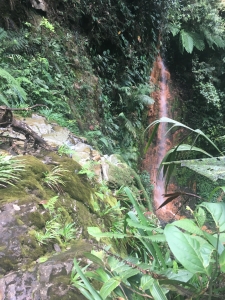
In July 2018, I traveled to Junín in the region of Intag, Ecuador to assist environmental studies professor Emily Billo in her research on resistance to resource extraction. As we walked through Junín’s Community Eco-Reserve to test the water for contamination, I could see the negative effects of the exploratory mining activities on the landscape. There was visible deforestation and erosion from mule trains carrying drilling equipment in and out of the reserve. My companions told me how they used to be able to hear many different kinds of birds; now I could only hear the loud hum of generators and drilling in the distance. Then there was the water which was visibly discolored orange or brown in some places.
Junín is well known for its highly biodiverse cloud forests. However, these could soon be destroyed by the creation of an open pit copper mine. Negative effects are already emerging in the water from mining exploration in the area, including increased conductivity, acidity, and toxic elements. The environment is also affected by deforestation, landslides, and loss of biodiversity. In addition to these effects, Junín and other communities that subsist on the land, raising cattle, practicing fair-trade coffee production, and eco-tourism would be displaced.
The small campesino community of Junín has been fighting mining for over 20 years.
In the 1990s, Japanese company Bishi Metals began exploration for copper. Community organizers, supported by the national environmental organization Acción Ecológica and the local environmental organization Defensa y Conservación Ecológica de Intag (DECOIN), mounted a resistance and ejected Bishi Metals. However, in the mid-2000s, Canadian company Ascendent Copper arrived. Confronted with community resistance that even challenged Ascendant’s hired paramilitary squad, the company left the region by the end of 2008. The documentary Under Rich Earth (2008) covers this incident and is available on YouTube.
The situation in Intag worsened after the 2008 election of president Rafael Correa, who promoted ‘post-neoliberal’ policies. Correa criticized exploitation by multinational corporations and introduced a new model of extraction led by the Ecuadorian state. Yet state control over extraction has not been better for all Ecuadorians as the state has criminalized anyone who protests extraction. The government also closed some environmental organizations and made it hard for organizations to get international funding.
Under Correa, the state-owned mining company of ENAMI partnered with CODLECO of Chile to explore minerals in Intag. In 2014, they forced entry with national police into Junín and their Community Ecological Reserve. While the community has rights to the surface of the land, the state has rights to the subsurface minerals. ENAMI kept a police presence in the area and even jailed the former president of Junín, Javier Ramírez, for 10 months under dubious charges. This presence led to a breakdown of community and people kept more to themselves. Divisions among families and friends had already existed for a while but worsened during this period of surveillance.
During our time in Junín, Professor Billo and I found that there were some changes in the social environment. ENAMI and CODELCO have solidified their presence over the past four years, employing local residents directly and indirectly. Other locals held to their values and made their living through more sustainable options of eco-tourism and fair-trade coffee. Miners and anti-miners were interacting again after previously ignoring each other, but the controversial topic of mining was off limits. However, life had already been permanently impacted by the past police presence and anti-mining residents in Junín still keep to themselves and their houses as Junín has become a company town for ENAMI.
In talking to community organizers, we found that the fight continues and protest still exists, but it’s not as strong or organized as it used to be. As one organizer shared, rather than being a step ahead of the company like before, they are a step behind. They don’t have the same financial resources as before and instead pay out of pocket to go to meetings and protests. Many community organizers are women, presenting a double or triple burden for them as they balance employment, household chores, and caring for children together with resistance efforts.
Yet there is still hope. Two other major mining projects in southern Ecuador have been temporarily halted for concerns related to water contamination and other environmental and social impacts. Although the current president of Ecuador, Lenín Moreno, is from the same political party as Correa, Moreno has not taken a strong stance on state mining and these recent halts suggest a possibility to slow or stop extractivism. In December, ENAMI’s Environmental Impact Statement will expire, concluding a 4-year exploration phase, but the company has petitioned the government to extend this phase. If not granted, the company would enter a 4-year analysis phase which would mean the company would employ fewer local residents. Additionally, in February there will be local elections, and organizers hope to see the success of some anti-mining candidates giving the resistance a stronger voice in the government.
Community organizers asked us to spread the word of their situation and fight so that more people know what is happening in Intag. Please share what you have just learned with others! If you’re looking for more information or ways to help, DECOIN continues to engage in anti-mining resistance efforts with residents of the region.
There will be an ICA to Ecuador in Summer 2019, which will spend a few days in Junín and the cloud forest region of Intag to learn more about organized resistance to mining and the sustainable alternatives some community members pursue. If you’re interested in learning more, the Info Session for Ecuador ICA is on Friday, October 19th, 3-4 p.m. in JR 251.
BY KATE LONGABAUGH
